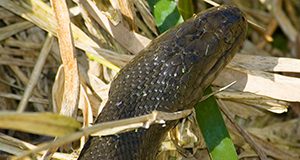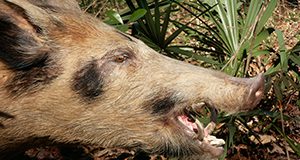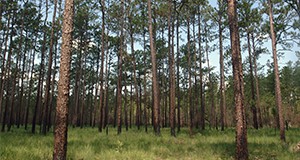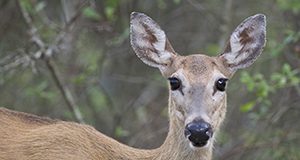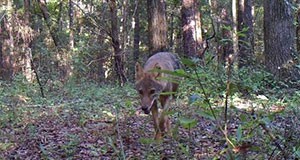Learn more about eastern indigo snakes!
The Wildlife of Florida Factsheet series was created to provide the public with a quick, accurate introduction to Florida's wildlife, including both native and invasive species. Authors Tyler Buckley and Raoul K. Boughton hope this 2-page quick guide and others in the series published by the UF/IFAS Department of Wildlife Ecology and Conservation will inspire readers to investigate wildlife in their own backyards and communities and understand the amazing biodiversity of wildlife in the state of Florida.
https://edis.ifas.ufl.edu/uw475
Tag: Raoul K. Boughton
White-tailed Deer of Florida
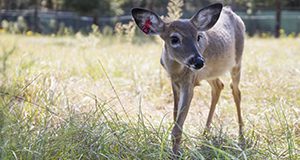
The white-tailed deer (Odocoileus virginianus) is the most economically important big game mammal in North America and Florida. This 12-page fact sheet written by Raoul K. Boughton, Bethany Wight, Samantha Wisely, Karen Hood, and Martin B. Main and published by the UF/IFAS Department of Wildlife Ecology and Conservation provides an overview of the various subspecies of white-tailed deer with populations in Florida and describes their history, biology, and management.
https://edis.ifas.ufl.edu/uw121
Wildlife of Florida Fact Sheets
Feral Swine Trapping: Techniques and Designs
Feral swine are an invasive or nuisance species in Florida and most other states because their incessant rooting is ruinous to natural and agricultural habitat. They loosen the soil, destroy native vegetation, and modify the natural chemistry and nutrients of the soil, causing widespread destruction in natural ecosystems, agricultural areas, livestock pastures, and residential areas. They also carry numerous diseases, some of which are transmittable to wild and domestic animals and humans. Trapping and removing swine from your property is an effective way to reduce or control feral swine populations. This 9-page fact sheet written by Bethany Wight and Raoul K. Boughton and published by the UF/IFAS Wildlife Ecology and Conservation Department describes the most commonly used trapping techniques and illustrates several trap and gate designs.
https://edis.ifas.ufl.edu/uw440
Landowner Cost-Share Incentives and Payments for Ecosystem Services: A Comparison of Key Program Features
Landowners who conduct land management activities that protect environmental benefits may be eligible for several types of financial assistance from the government, but not all incentive strategies are the same. This 4-page fact sheet written by Melissa M. Kreye, Elizabeth Pienaar, and Raoul K. Boughton and published by the Department of Wildlife Ecology and Conservation compares traditional cost-share programs offered to landowners through federal agencies and a new type of market-based incentive program called payments for ecosystem services (PES). The information inside can help private landowners understand the advantages and limitations of both approaches and guide decision-makers in designing effective future conservation incentive programs.
edis.ifas.ufl.edu/uw415
Using the Ecosystem Services Approach to Advance Conservation Efforts on Private Lands
Decision-makers in Florida have shown increased interest in using the Ecosystem Services (ES) approach to reward ecosystem conservation efforts on private lands. For example, payments for ecosystem services (PES) strategies have been effective in motivating landowners to conserve ecosystems on their land. Some landowners may find a better understanding of the ES approach to be useful when deciding to participate in a PES program. This 5-page fact sheet written by Melissa M. Kreye, Elizabeth Pienaar, Raoul K. Boughton, and Lindsey Wiggins and published by Department of Wildlife Ecology and Conservation will provide landowners, Extension agents, government and agency leaders, and other stakeholders with a better understanding of how ES are classified, the different ways ES can be valued, how quantifying ES values can help support conservation efforts on private lands in Florida, and a few of the challenges inherent in using the ES approach.
edis.ifas.ufl.edu/uw414
Rancher Perceptions of the Coyote in Florida
Throughout the continental United States and large portions of Canada and Central America, changes people make to the landscape such as the clearing of forested land and the extermination of larger predators like gray and red wolves have made the environment perfect for the adaptive coyote. Coyotes have rapidly taken advantage of these environmental shifts and expanded into new areas, now including all 67 counties in Florida and even Key Largo. Each year more people in Florida catch a glimpse of a coyote crossing a road or running across open fields, or notice coyote scat along a hiking trail–and farmers and ranchers are seeing signs of coyotes on their farms.
As coyotes become a fixture of the Florida landscape, potential grows for conflict with humans. Coyotes are in Florida to stay, and understanding the agricultural community’s perception of their influence on livestock and wildlife is important to developing effective policies for coyote management. This 4-page fact sheet written by Raoul K. Boughton, Bethany Wight, and Martin B. Main and published by the Wildlife Ecology and Conservation Department provides results of ongoing statewide surveys of ranchers in Florida regarding the influence of coyotes on their operations.
